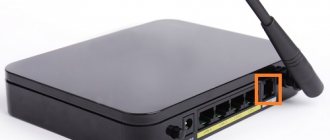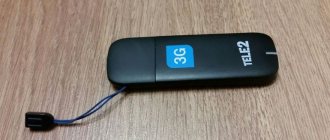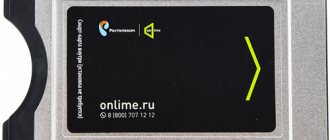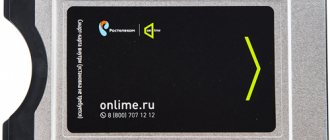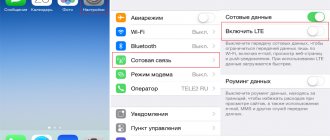In this article we will look at the main features of a SIP phone: connection, configuration and service characteristics of the most popular types of these devices.
The main advantage of IP telephony over traditional wired and mobile communications - cost-effectiveness - is described in many publications and presentations. But are low tariffs the only reason for the enormous popularity of this telecommunications technology? Of course, such a high degree of attractiveness would hardly have been achieved only thanks to low charges for telephone calls, if this Internet service was inferior in the quality of voice transmission and the comfort of its use by the consumer to the services of competitors. And if the level of the first two characteristics - “efficiency” and “quality” - is ensured by network equipment and data transmission channels, then the third - “comfort of use” - is determined by the terminal device with which the consumer has direct contact - an IP phone.
The second “name” of this device, which has recently prevailed in professional and mass publications, is SIP phone. The term “IP telephony” today is also often replaced by the recently appeared synonym “SIP telephony”, since in IP networks, to establish a communication session between subscribers, the vast majority of VoIP equipment supports Session Initiation Protocol - SIP, which is recognized as the main one. Although some SIP phone models can work with other connection initiation software, such as H.323 (the predecessor to SIP) and MGCP (Media Gateway Control Protocol).
A SIP phone is usually called a desktop design version, the design of which is so close to the usual look of an analog phone that from a distance they are practically indistinguishable. This device connects to a corporate IP network or directly to the Internet.
The second device solution for SIP telephony is implemented according to the “do it yourself” principle: any analog telephone operating in the company is connected to a VoIP (SIP) gateway, and it, in turn, to an IP or Internet network. In this case, you can reduce the cost of IP equipment (a VoIP gateway is cheaper than a SIP phone), but the functionality of such a “SIP tandem” will be limited by the capabilities of the analog phone used. In the same way, a VoIP gateway can be implemented between an office PBX operated by an enterprise and the Internet channel of a SIP provider. But in this case, again, you shouldn’t hope for the full functionality of SIP telephony.
To increase the comfort of “communication” with SIP phones, some of them are equipped with touch screens
The third hardware embodiment of a SIP phone is a Wi-Fi SIP phone. It looks similar to a mobile phone, but it is designed to access the Internet via a Wi-Fi network.
And finally, the fourth means of acquiring a SIP terminal is to use a PC (or laptop) with SoftPhone software installed on it. This solution is called a “softphone” or “softphone”.
SIP phone: connection and setup
A desktop SIP phone connects to the company’s local computer network, which is usually an Ethernet network, for which there is an RJ-45 WAN connector on the device body. The “gentleman’s set” of SIP phone functions (naturally, in addition to voice communication) includes speakerphone (speakerphone), support for voice mail services, call forwarding, transfer and call hold.
After connecting the SIP phone to the Internet and registering on the SIP provider’s server (this requires simple setup - you take all the necessary settings on the SIP provider’s website), the device is ready to perform all the functions included in it by the manufacturer (note that a number of SIP phone models can be connected to several providers).
Typical settings for a traditional desktop SIP phone include the following parameters:
- SIP Server / Registrar (your provider's SIP server address)
- Username / Login / User ID (username or SIP identifier)
- Password
Additionally, when setting up a SIP phone, the following parameters may be requested:
- Outbound proxy (usually the same as your provider's SIP server address)
- Server / Proxy port (usually specify port 5060 UDP or TCP)
- Transport protocol (usually TLS, UDP or TCP)
- Authorization name / Auth ID (usually indicate your SIP ID)
- Display Name (your name or any other word in English)
Data you will need when choosing any of the above methods
With almost any method of connecting and setting up IP telephony, you will definitely need 3 main “artifacts”:
- Username (login. It is also the line number.
- Password.
- Hostname or ISP address.
If you need to “make friends” of IP telephony with CRM, you will need data such as ID (APP ID) and secret key (App Secret).
All this data can be viewed in your personal account or in a letter that comes to the e-mail specified during registration.
SIP phone: capabilities, connection, setup
In addition to the usual voice communication functions, many SIP terminals offer intercom and audio conferencing capabilities and support for video calls. At the same time, QоS (Quality of Service) software ensures high sound quality. It is also important that power supply to SIP phones can be carried out using PoE technology (Power over Ethernet - power supply over a local computer network).
Services provided by SIP phones during conversations include displaying the current time, duration of communication with subscribers (as well as information about them) and missed calls. “Instrumental” services include programmable keys (for quickly dialing subscriber numbers and frequently used device functions), of which today there can be up to two dozen, and connecting an expansion panel to the phone allows you to increase their number to 64. In addition, up to six personal SIP accounts can be configured on an advanced SIP phone.
If you need to use both SIP and traditional telephony, you can install dual-mode devices in the office, which are connected to the Ethernet network and to the city telephone network or office PBX using the connectors available on their cases.
How SIP telephony works
Step-by-step algorithm of how a SIP call works:
- The call comes from a SIP phone.
- The call passes through the PBX (cloud or office) and enters the IP network.
- The call enters the Internet through the NNI (network-to-network interface) - this is a kind of connecting link between the Internet provider and the telephony network. Depending on the ISP, the SIP call will be routed through either a public or private route. The difference is in the level of security: the public route is not encrypted, while the private route goes directly through the client's Internet connection and does not end up on the public network.
- SIP goes from the Internet (read: public space) to the Nextel network, and then goes to the IP network of a specific recipient.
- Then there are two options. If a specific call recipient is using a digital device (connected to the internet), their call goes through directly. If he is using an analog telephone, then the call is routed through an analog telephone adapter (ATA).
- The call rings, the subscriber can pick up the phone!
SIP makes calls via the Internet, the call can go to any device: mobile phone, analog (landline) number, telephone connection in the elevator of a residential building, other business telephone systems - in general, without restrictions. And the transfer of a signal from an IP network through an analog adapter takes a matter of seconds!
This is what the SIP call algorithm looks like in the picture:
Wi-Fi SIP phones
For wireless connection to SIP telephony services, Wi-Fi SIP phones are produced - devices operating in Wi-Fi networks
Away from home and office, you can do without expensive mobile roaming (especially international) if you have a Wi-Fi SIP phone with you. The main thing is to get into the wireless Internet coverage area - the Wi-Fi zone. In this “free Internet territory”, a Wi-Fi SIP phone will provide communication with traditional, mobile and IP telephony subscribers located in any country in the world. Its setup is the same as the desktop model.
Wi-Fi SIP phones have the functionality of office SIP phones. However, some vendors provide consumers with the opportunity to independently add new functions to Wi-Fi devices and change existing ones. Such operations can be performed, for example, with the AddPac AP-WP100 Wi-Fi SIP phone, which is based on a high-performance RISC processor and DSP using the APOS operating system. To upgrade the functionality of this phone, you only need to take two simple steps: 1) download software from the manufacturer's website that provides the desired change, 2) reboot the OS.
To ensure that the consumer does not “lose” contact with employees and friends outside the Wi-Fi zone and does not carry an additional mobile device with him, dual-mode GSM/Wi-Fi phones are produced that switch to cellular roaming in the absence of wireless Internet coverage.
Advantages of SIP telephony
- Management . Unlike PRI-based solutions, SIP is not tied to a physical copper channel, that is, it is not limited by the presence of a local communication network. SIP allows you to create multiple virtual paths to ensure that your SIP network is always up and running. This not only increases the availability of communication (which is extremely important for business!), but also saves time on management. No wires, no problems with maintenance, repair, replacement...
- Profitability . SIP allows you to reduce costs through a more flexible payment system. In particular, if you use multi-channel lines for business, it is you who determines the required number of channels. This means you don’t overpay for a standard set that you may not need at all. Choose a solution that meets your specific business needs and pay only for it.
- Scalability . SIP is much easier to scale; thanks in no small part to the simple control via the user interface. That is, when you need to increase the number of lines for operators, this can be solved with a couple of clicks in your personal account (which make changes to the operation of the Nextel cloud PBX), rather than working with a real telephone exchange in the office, which requires a specialist who may have limited resources and another 1000 and 1 limit.
- Unification . SIP communication is not limited locally, is flexible and accessible - much more affordable than traditional analogue. This is especially true in our time, when remote work is becoming the norm, which means we need solutions that will maintain the quality of business processes regardless of the location of employees. Nextel service allows you to make high-quality calls wherever you are.
Soft SIP phone: setup
To use SIP telephony services, you can do without a SIP device by installing a SoftPhone class program (software SIP phone) on your PC, which emulates the functionality of a landline SIP phone on your computer. If your computer does not have a built-in microphone and speaker, then these devices must be connected to it. And if you need to make a video call, you will also need to connect a webcam. Then, as in previous scenarios of preparing to join the community of SIP telephony users, register with a SIP provider. Setting up a software SIP phone is similar to a desktop device. The minimum settings are usually required: SIP server address, login and password.
A soft SIP phone works only when the computer is running, and if the PC is turned off or frozen, then telephone communication is impossible
The resulting computer-software conglomerate, called a softphone (or softphone), provides the user with the same range of capabilities as an office SIP phone.
Obviously, instead of a microphone and audio system, you can connect a more convenient attribute of voice communication to your PC - a telephone headset.
Sometimes a softphone uses a USB SIP phone as a speech transceiver terminal, which, however, can be called a phone with great stretch, since it only superficially resembles a mobile device with a keyboard and screen, and only a microphone and speaker are located inside it. And the work of all the “electronic stuffing” of the phone is performed by a program installed on the PC. But if the user is more accustomed to talking on the phone with the receiver pressed to his ear, then this opportunity is provided to him by a USB SIP phone.
What you need to receive and send calls via SIP
SIP allows you to establish communication via a computer/phone and the Internet. Without any boundaries! Voice and video calls over SIP are free, there are no restrictive laws for them, there is no roaming or per-minute charges. This is a cost-effective part of Internet telephony that allows you to take advantage of the benefits of VoIP (IP telephony) while reducing communication costs.
To get started, you need to get a SIP address, and then install and configure a SIP client on your computer or phone. Let's look at everything you need to get started with SIP in more detail:
- SIP address/account. It can be obtained from an IP telephony provider, for example, by creating a free account in the Nextel service;
- SIP client. This is an application for a computer or mobile device that works as a kind of softphone and at the same time an interface for telephony management;
- Internet. IP telephony is telephony over the Internet protocol, and therefore a stable connection with good bandwidth is a must-have;
- communication device. Headphones and a microphone or headset - and you are ready to talk!
Cost of IP telephony
Creating a type of communication such as IP telephony with your own hands is an excellent solution, but before you get down to business, you need to find out how much it costs ordinary users. It is worth noting that this nuance is quite relevant. VoIP telephony has spread throughout the world. Due to what? It not only allows you to save money, but also provides excellent quality communications and so on. This protocol also provides free calls to a subscriber who is registered with the same provider.
Everyone knows exactly how regular traditional telephony works. The further away the interlocutor is located, the more expensive a minute of communication will be. IP telephony allows you to talk to a person on the other side of the planet for free. No need to pay for voice data and connection. There are no additional tariffs. Due to this, the fee for a call to a subscriber who is on another network and registered with a “left” provider will be much lower than that of a regular mobile operator.
There are no charges for calls within the network. For the vast majority of incoming calls, you also don’t have to pay money for them. For landline and mobile numbers, a fee of about 40 kopecks per minute is charged. It's quite a bit.
You will need to pay for using direct numbers. It is impossible to say the exact cost, but it is small and monthly.
Connection diagram
There are several schemes for connecting IP telephony. The most optimal way is to connect using a Virtual PBX, software provided by the telephony operator. One of the advantages of this method is the simplicity of organization and the low amount of the initial contribution. You just need to conclude an agreement with the operator, select a number and describe the tasks of your business, and also purchase VoIP phones or VoIP gateways (if you install a softphone on your computer or integrate telephony and CRM, you can process calls through a computer and a headset, without additional equipment; also mobile application for calls). The operator's technical support will be happy to help you understand the settings of additional equipment, as well as set up IP telephony. In addition, UIS has a catalog of equipment from reliable manufacturers that is recommended to be used for work.
Stage four – using multiple phones
Some families need several devices to work comfortably with telephony. It should be noted that in order for the two city devices to function, it will be necessary to create separate lines and conclude a couple of contracts. This requires a lot of money, time and nerves, since in the Russian Federation providers consider applications for connection for quite a long time.
Digital telephony makes it easier to use multiple devices. When registering an account, many lines are immediately created. They make it possible to simultaneously receive and call from everyone. However, this is available not in the “Basic” tariff, but in the “Premium” tariff. Subscribing to it costs a little more, but for busy and serious people who are constantly on the phone, it will be suitable. This tariff supports the creation of up to 100 lines simultaneously. Most often, such services are used by offices.
In order not to purchase several separate phones for your apartment, you can buy a device that supports work with additional cordless handsets. Each of them is allowed to be assigned to its “own” line. More expensive models are capable of working with several accounts and will optimally distribute them automatically between handsets.
Paid services
To make calls, you need to top up your internal account. After this operation, IP telephony systems will provide access to calls both within the Russian Federation and abroad.
If desired, you can purchase a direct number. It is assigned to a specific city. There are about a thousand of them. Why is this necessary? You can answer calls to an American number while in Russia. This allows you not to spend a lot of money and save traffic.



